Dung beetle
| Dung beetle | |
|---|---|
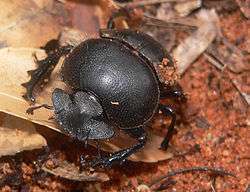 | |
| Scarabaeus viettei (syn. Madateuchus viettei, Scarabaeidae) in dry spiny forest close to Mangily, western Madagascar | |
| Scientific classification | |
| Kingdom: | Animalia |
| Phylum: | Arthropoda |
| Class: | Insecta |
| Order: | Coleoptera |
| Suborder: | Polyphaga |
| Superfamily: | Scarabaeoidea (in part) |
| Family: | Scarabaeidae |
Dung beetles are beetles that feed partly or exclusively on dung. A dung beetle can bury dung 250 times heavier than itself in one night.[1]
Many dung beetles, known as rollers, roll dung into round balls, which are used as a food source or breeding chambers. Others, known as tunnelers, bury the dung wherever they find it. A third group, the dwellers, neither roll nor burrow: they simply live in manure. They are often attracted by the dung collected by burrowing owls. Dung Beetles can grow to 3 cm long and 2 cm wide.
All the species belong to the superfamily Scarabaeoidea; most of them to the subfamilies Scarabaeinae and Aphodiinae of the family Scarabaeidae (scarab beetles). As most species of Scarabaeinae feed exclusively on feces, that subfamily is often dubbed true dung beetles. There are dung-feeding beetles which belong to other families, such as the Geotrupidae (the earth-boring dung beetle). The Scarabaeinae alone comprises more than 5,000 species.[2]
Dung beetles are currently the only known non-human animal to navigate and orient themselves using the Milky Way.[3][4]
Taxonomy
Dung beetles are not a single taxonomic group; dung feeding is found in a number of families of beetles, so the behaviour cannot be assumed to have evolved only once.
- Coleoptera (order), beetles
- Scarabaeoidea (superfamily), scarabs (most families in the group do not use dung)
- Geotrupidae (family), "earth-boring dung beetles"[5]
- Scarabaeidae (family), "scarab beetles" (not all species use dung)
- Scarabaeinae (subfamily), "true dung beetles"[6]
- Aphodiinae (subfamily), "small dung beetles" (not all species use dung)[7]
- Scarabaeoidea (superfamily), scarabs (most families in the group do not use dung)
Ecology and behavior
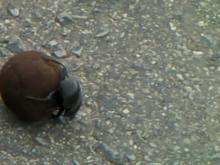
Dung beetles live in many habitats, including desert, farmland, forest, and grasslands. They do not prefer extremely cold or dry weather. They are found on all continents except Antarctica. They eat the dung of herbivores and omnivores, and prefer that produced by the latter.[8] Many of them also feed on mushrooms and decaying leaves and fruits. One type living in Central America, Deltochilum valgum, is a carnivore preying upon millipedes. Those that eat dung do not need to eat or drink anything else, because the dung provides all the necessary nutrients. Most dung beetles search for dung using their sensitive sense of smell. Some smaller species simply attach themselves to the dung-providers to wait for the dung. After capturing the dung, a dung beetle rolls it, following a straight line despite all obstacles. Sometimes, dung beetles try to steal the dung ball from another beetle, so the dung beetles have to move rapidly away from a dung pile once they have rolled their ball to prevent it from being stolen. Dung beetles can roll up to 10 times their weight. Male Onthophagus taurus beetles can pull 1,141 times their own body weight: the equivalent of an average person pulling six double-decker buses full of people.[9]
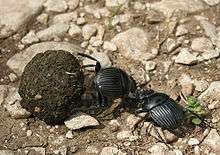
A species of dung beetle (the African Scarabaeus zambesianus) navigates by polarization patterns in moonlight, the first animal known to do so.[10][11][12][13] Dung beetles can also navigate when only the Milky Way or clusters of bright stars are visible,[14] making them the only insects known to orient themselves by the galaxy.[3][14]

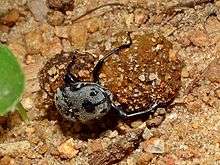
The "rollers" roll and bury a dung ball either for food storage or for making a brooding ball. In the latter case, two beetles, one male and one female, stay around the dung ball during the rolling process. Usually it is the male that rolls the ball, while the female hitch-hikes or simply follows behind. In some cases, the male and the female roll together. When a spot with soft soil is found, they stop and bury the ball, then mate underground. After the mating, both or one of them prepares the brooding ball. When the ball is finished, the female lays eggs inside it, a form of mass provisioning. Some species do not leave after this stage, but remain to safeguard their offspring. The dung beetle goes through a complete metamorphosis. The larvae live in brood balls made with dung prepared by their parents. During the larval stage, the beetle feeds on the dung surrounding it.
The behavior of the beetles was poorly understood until the studies of Jean Henri Fabre in the late 19th century. For example, Fabre corrected the myth that a dung beetle would seek aid from other dung beetles when confronted by obstacles. By observation and experiment, he found the seeming helpers were in fact awaiting an opportunity to steal the roller's food source.[15]
Benefits and uses
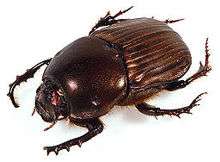
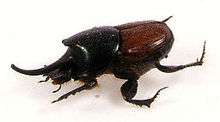
Dung beetles play a remarkable role in agriculture. By burying and consuming dung, they improve nutrient recycling and soil structure.[16] They also protect livestock, such as cattle, by removing the dung which, if left, could provide habitat for pests such as flies. Therefore, many countries have introduced the creatures for the benefit of animal husbandry. In developing countries, the beetles are especially important as an adjunct for improving standards of hygiene. The American Institute of Biological Sciences reports that dung beetles save the United States cattle industry an estimated US$380 million annually through burying above-ground livestock feces.[17]
In Australia, the Commonwealth Scientific and Industrial Research Organisation (CSIRO) commissioned the Australian Dung Beetle Project (1965–1985) which, led by George Bornemissza, sought to introduce species of dung beetles from South Africa and Europe. The successful introduction of 23 species was made, most notably Digitonthophagus gazella and Euoniticellus intermedius, which has resulted in improvement of the quality and fertility of Australian cattle pastures, along with a reduction in the population of pestilent bush flies by around 90 percent.[18]
An application has been made by Landcare Research to import up to 11 species of dung beetle into New Zealand.[19] As well as improving pasture soils the Dung Beetle Release Strategy Group say that it would result in a reduction in emissions of nitrous oxide (a greenhouse gas) from agriculture.[20] There is, however, strong opposition from some at the University of Auckland, and a few others, based on the risks of the dung beetles acting as vectors of disease.[21][22] There are public health researchers at the University of Auckland who agree with the current EPA risk assessment [23] and indeed there are several Landcare programmes in Australia that involve schoolchildren collecting dung beetles.[24]
The African dung beetle, D. gazella, was introduced in several locations in North and South America and has been spreading its distribution to other regions by natural dispersal and accidental transportation, and is now probably naturalized in most countries between México and Argentina. The exotic species might be useful for controlling diseases of livestock in commercial areas, and might displace native species in modified landscapes, however data is not conclusive about its effect on native species in natural environments and further monitoring is required.[25]
Like many other insects, the (dried) dung beetle, called qianglang (蜣蜋) in Chinese, is used in Chinese herbal medicine. It is recorded in the "Insect section" (蟲部) of the Compendium of Materia Medica, where it is recommended for the cure of 10 diseases.
In Isan, Northeastern Thailand, the local people famously eat many different kinds of insects including the dung beetle. There is an Isan song กุดจี่หายไปใหน "Where did the Dung Beetle go", which relates the replacement of water buffalo with the "metal" buffalo, which doesn't provide the dung needed for the dung beetle. Hence, the increasing rarity of the dung beetle in the agricultural region.
Scarab in ancient Egypt
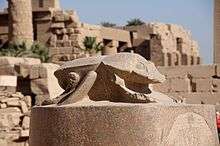
Several species of the dung beetle, most notably the species Scarabaeus sacer (often referred to as the sacred scarab), enjoyed a sacred status among the ancient Egyptians.
| ||
| ḫpr in hieroglyphs |
|---|
Popular interpretation in modern academia theorizes the hieroglyphic (the language of Egyptians) image of the beetle represents a triliteral phonetic that Egyptologists transliterate as xpr or ḫpr and translate as "to come into being", "to become" or "to transform". The derivative term xprw or ḫpr(w) is variously translated as "form", "transformation", "happening", "mode of being" or "what has come into being", depending on the context. It may have existential, fictional, or ontologic significance.
The scarab was linked to Khepri ("he who has come into being"), the god of the rising sun. The ancients believed that the dung beetle was only male in gender, and reproduced by depositing semen into a dung ball. The supposed self-creation of the beetle resembles that of Khepri, who creates himself out of nothing. Moreover, the dung ball rolled by a dung beetle resembles the sun. Plutarch wrote:
The race of beetles has no female, but all the males eject their sperm into a round pellet of material which they roll up by pushing it from the opposite side, just as the sun seems to turn the heavens in the direction opposite to its own course, which is from west to east.[26]
The ancient Egyptians believed that Khepri renewed the sun every day before rolling it above the horizon, then carried it through the other world after sunset, only to renew it, again, the next day. Some New Kingdom royal tombs exhibit a threefold image of the sun god, with the beetle as symbol of the morning sun. The astronomical ceiling in the tomb of Ramses VI portrays the nightly "death" and "rebirth" of the sun as being swallowed by Nut, goddess of the sky, and re-emerging from her womb as Khepri.
The image of the scarab, conveying ideas of transformation, renewal, and resurrection, is ubiquitous in ancient Egyptian religious and funerary art.
Excavations of ancient Egyptian sites have yielded images of the scarab in bone, ivory, stone, Egyptian faience, and precious metals, dating from the Sixth Dynasty and up to the period of Roman rule. They are generally small, bored to allow stringing on a necklace, and the base bears a brief inscription or cartouche. Some have been used as seals. Pharaohs sometimes commissioned the manufacture of larger images with lengthy inscriptions, such as the commemorative scarab of Queen Tiye. Massive sculptures of scarabs can be seen at Luxor Temple, at the Serapeum in Alexandria (see Serapis) and elsewhere in Egypt.

The scarab was of prime significance in the funerary cult of ancient Egypt. Scarabs, generally, though not always, were cut from green stone, and placed on the chest of the deceased. Perhaps the most famous example of such "heart scarabs" is the yellow-green pectoral scarab found among the entombed provisions of Tutankhamen. It was carved from a large piece of Libyan desert glass. The purpose of the "heart scarab" was to ensure that the heart would not bear witness against the deceased at judgement in the Afterlife. Other possibilities are suggested by the "transformation spells" of the Coffin Texts, which affirm that the soul of the deceased may transform (xpr) into a human being, a god, or a bird and reappear in the world of the living.
One scholar comments on other traits of the scarab connected with the theme of death and rebirth:
It may not have gone unnoticed that the pupa, whose wings and legs are encased at this stage of development, is very mummy-like. It has even been pointed out that the egg-bearing ball of dung is created in an underground chamber which is reached by a vertical shaft and horizontal passage curiously reminiscent of Old Kingdom mastaba tombs."[27]
In contrast to funerary contexts, some of ancient Egypt's neighbors adopted the scarab motif for seals of varying types. The best-known of these being Judean LMLK seals (8 of 21 designs contained scarab beetles), which were used exclusively to stamp impressions on storage jars during the reign of Hezekiah.
The scarab remains an item of popular interest thanks to modern fascination with the art and beliefs of ancient Egypt. Scarab beads in semiprecious stones or glazed ceramics can be purchased at most bead shops, while at Luxor Temple a massive ancient scarab has been roped off to discourage visitors from rubbing the base of the statue "for luck".
In culture
In literature
In Aesop's fable "The Eagle and the Beetle", the eagle kills a hare that has asked sanctuary with a beetle. The beetle then takes revenge by twice destroying the eagle's eggs. The eagle, in despair, flies up to Olympus and places her latest eggs in Zeus's lap, beseeching the god to protect them. When the beetle finds out what the eagle has done, it stuffs itself with dung, goes straight up to Zeus and flies right into his face. Zeus is startled at the sight of the unpleasant creature, jumping to his feet so that the eggs are broken. Learning of the origin of their feud, Zeus attempts to mediate and, when his efforts to mediate fail, he changes the breeding season of the eagle to a time when the beetles are not above ground.
Aristophanes alluded to Aesop's fable several times in his plays. In Peace, the hero rides up to Olympus to free the goddess Peace from her prison. His steed is an enormous dung beetle which has been fed so much dung that it has grown to monstrous size.
Hans Christian Andersen's "The Dung Beetle" tells the story of a dung beetle who lives in the stable of the king's horses in an imaginary kingdom. When he demands golden shoes like those the king's horse wears and is refused, he flies away and has a series of adventures, which are often precipitated by his feeling of superiority to other animals. He finally returns to the stable having decided (against all logic) that it is for him that the king's horse wears golden shoes.[28]
In Franz Kafka's The Metamorphosis, the transformed character of Gregor Samsa is called an "old dung beetle" (alter Mistkäfer) by the charwoman.
See also
- Catharsius, an important dung beetle genus in African and Asian environments
- Addo Elephant National Park, site of the largest remaining population of the endangered flightless dung beetle (Circellium bacchus).
- List of dung beetle and chafer (Scarabaeoidea) species recorded in Britain
- Rotating locomotion in living systems
References
- ↑ "Some Less Known Fascinating Facts about Dung Beetle". IANS. news.biharprabha.com. Retrieved 21 April 2014.
- ↑ Frolov, A.V. "Subfamily Scarabaeinae: atlas of representatives of the tribes (Scarabaeidae)". Retrieved on 2007-08-02.
- 1 2 Wits University (24 January 2013). "Dung Beetles Follow the Milky Way: Insects Found to Use Stars for Orientation". ScienceDaily. Retrieved 25 January 2013.
- ↑ Dell'Amore, Christine. "Dung Beetles Navigate Via the Milky Way, First Known in Animal Kingdom". News Watch. National Geographic Society. Retrieved 25 January 2013.
- ↑ "Geotrupidae (earth-boring dung beetles)". kerbtier.de. Retrieved 28 March 2015.
- ↑ "Scarabaeinae dung beetles". Retrieved 28 March 2015.
- ↑ Skelley, P. E. Aphodiinae. Generic Guide to New World Scarab Beetles. University of Nebraska State Museum. 2008 Version.
- ↑ Dell'Amore, Christine. "Dung Beetles' Favorite Poop Revealed". National Geographic. National Geographic Society. Retrieved 22 September 2016.
- ↑ Khaleeli, Homa (24 March 2010). "Just how strong is a dung beetle?". The Guardian. London.
- ↑ Dacke, M.; Nilsson, D. E.; Scholtz, C. H.; Byrne, M.; Warrant, E. J. (2003). "Animal behaviour: Insect orientation to polarized moonlight". Nature. 424 (6944): 33. doi:10.1038/424033a.
- ↑ Milius, Susan (2003). "Moonlighting: Beetles navigate by lunar polarity". Science News. 164 (1): 4.
- ↑ Roach, John (2003). "Dung Beetles Navigate by the Moon, Study Says", National Geographic News. Retrieved on 2007-08-02.
- ↑ Milius, S. (2003). "Moonlighting". Science News. 164: 4. doi:10.2307/3981988. JSTOR 3981988.
- 1 2 Dacke, Marie; Baird, Emily; Byrne, Marcus; Scholtz, Clarke H.; Warrant, Eric J. (2013). "Dung Beetles Use the Milky Way for Orientation". Current Biology. 23 (4): 298. doi:10.1016/j.cub.2012.12.034. PMID 23352694.
- ↑ Fabre, J. Henri (1949). The Insect World of J. Henri Fabre. De Mattos, Alexander Teixeira (translator). Dodd, Mead & Company. p. 99.
I ask myself in vain what Proudhon introduced into Scarabaean morality the daring paradox that 'property means plunder', or what diplomatist taught the Dung-beetle the savage maxim that 'might is right'.
- ↑ Brown, J.; Scholtz, C. H.; Janeau, J. L.; Grellier, S.; Podwojewski, P. (2010). "Dung beetles (Coleoptera: Scarabaeidae) can improve soil hydrological properties". Applied Soil Ecology. 46: 9. doi:10.1016/j.apsoil.2010.05.010.
- ↑ Losey, J. E.; Vaughan, M. (2006). "The Economic Value of Ecological Services Provided by Insects" (PDF). BioScience. 56 (4): 311–23. doi:10.1641/0006-3568(2006)56[311:TEVOES]2.0.CO;2.
- ↑ Bornemissza, G. F. (1976). "The Australian dung beetle project 1965–1975". Australian Meat Research Committee Review. 30: 1–30.
- ↑ "Application summary – ERMA200599" (PDF). ERMA. Retrieved 12 December 2010.
- ↑ Ihaka, James (24 September 2010). "Let's roll... dung beetle to combat global warming". The New Zealand Herald. Retrieved 12 December 2010.
- ↑ 17 Aug 2014, 01:09 am (2012-05-07). "Experts dump on dung beetle". Fwplus.co.nz. Retrieved 2014-08-16.
- ↑ "Grant Guilford: Dung beetle plan a risky gamble". Nzherald.co.nz. Retrieved 2014-08-16.
- ↑ drj9 (2013-03-17). "'Fickle thy name is' vox populi : puzzle over dung beetles and science reporting". Journal of Outrageous Speculation. Janinepaynter.wordpress.com. Retrieved 2014-04-22.
- ↑ "Release Programme | Dung Beetles in New Zealand". Dungbeetle.org.nz. 2013-09-26. Retrieved 2014-04-22.
- ↑ Ferrer-Paris, José R. (2014). "El escarabajo estercolero africano, Digitonthophagus gazella, (Coleoptera: Scarabaeidae) en la región Neotropical, ¿beneficioso o perjudicial?". Boletín de la Red Latinoamericana para el Estudio de Especies Invasoras. 4 (1): 41–48.
- ↑ "Isis and Osiris", Moralia, in volume V of the Loeb Classical Library edition, 1936, now in the public domain. Retrieved on 2007-08-02.
- ↑ Andrews, Carol (1994). Amulets of Ancient Egypt. Texas: University of Texas Press. ISBN 0-292-70464-X. p. 51.
- ↑ Andersen, Hans Christian; James, M. R. (trans.) (1930). The Beetle. Hans Andersen Forty-Two Stories. Faber and Faber.
External links
| Wikispecies has information related to: Scarabaeinae |
| Wikispecies has information related to: Aphodiinae |
| Wikimedia Commons has media related to Dung beetles. |
- Feature: 'What to do with too much poo' – The success story behind the introduction of dung beetles in Australia at cosmosmagazine.com
- Beetles as religious symbols at insects.org
- Scarabaeinae Research Network
- Dung beetles at the Australia Museum
- Catharsius, an international group working on taxonomy and ecology of Western African dung beetles
- Tomas Libich, Congo dung beetle sp1 and Congo dung beetle sp2 photos
- Dung Beetles in action (video) by The WILD Foundation/Boyd Norton
- Dung Beetles in New Zealand (proposed release of dung beetles, with background research)
- Marcus Byrne The dance of the dung beetle Ted conference about dung beetle behavior.